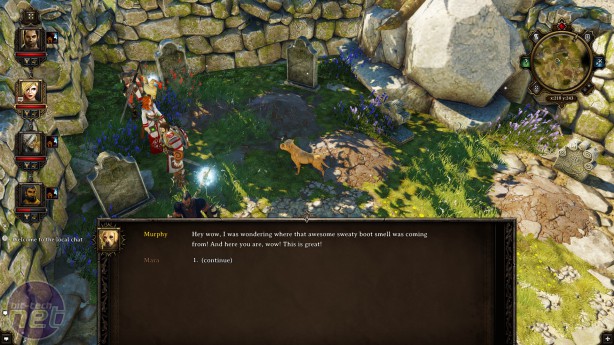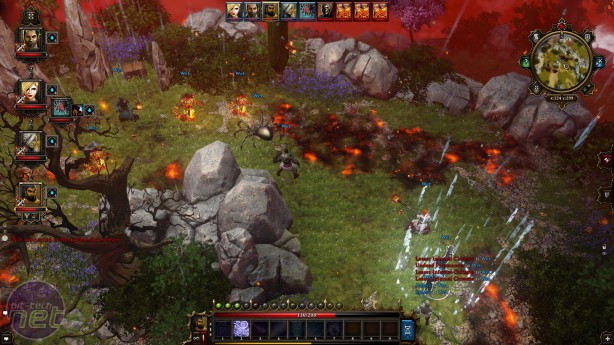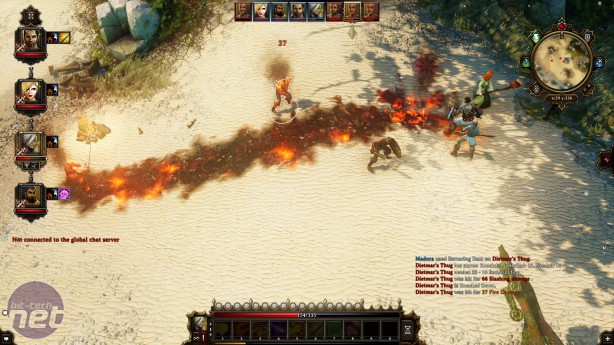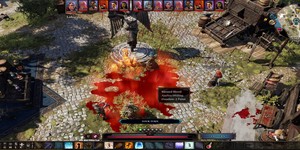
But everyone has some kind of quirk or personality trait that makes them interesting to interact with, whether it’s the Mayor’s Orcish librarian who has eschewed her lust for blood in favour of a love of books, a wizard with a penchant for talking in bad similes, or simply an undead buccaneer named "Pontius Pirate", wherever it can Original Sin injects a pinch of daft humour into its script, avoiding the stilted tone that plagues so many fantasy games.
Quests also sprinkle silly humour amid the more serious storyline, helping a lonely human-loving troll get a date, or locating the missing cranium of a headless ghost. The only time the writing’s lack of subtlety really plays against it is in the “arguments” you can roleplay between your lead party characters, in which one will offer an opinion and the other can either agree or disagree, which affects their personality traits. It all feels a little too binary and arbitrary to be truly effective.
But there’s more to the game's dialogue than entertainment. It also functions as one of various methods of solving quests and progressing through the game. Many characters can be charmed, intimidated or reasoned with to avoid conflict or convince them to give you something you need. If your people skills are somewhat lacking, however, you could always try playing detective.
One of Original Sin’s most interesting innovations is how it turns houses, dungeons and other locations into little puzzles. Almost every object you can add into your inventory has a physical presence in the game world; keys, notes, books, spells etc. Meanwhile, almost every object in the game can be physically moved around such as barrels, crates, paintings and bookshelves. Larian often combine the two to hide keys underneath beds or tables, or conceal secret switches behind paintings. It’s fun zooming right into a townhouse and searching it manually for hidden objects while marvelling at the detail Larian have packed into their miniature world. In many dungeons you can even ask the rats for hints regarding the nature of these secrets, which is another lovely little touch.
Original Sin is filled with these, little innovations that make so much logical sense within the game world. It’s a very tactile and very flexible RPG in terms of how you can approach it. And then of course there’s Original Sin’s most prominent innovation, found in the combat.
Structurally Original Sin’s combat is typical turn-based RPG fare. All characters, whether melee, ranged or magic focussed posses a number of action points using which they can move, attack, or use special skills. These are all familiar mixture of buffs, debuffs, power attacks, fireballs, lightning bolts and so forth. Regarding the latter two, Original Sin’s fireballs and lightning bolts aren’t like those found in other fantasy RPGs. The four “elemental” schools of magic in Original Sin, fire, water, earth and air, can be combined to create deadly traps, devastating area-of-effect attacks and explosive chain-reactions.
For example, using a raincloud spell to put out a fire will cause a steam-cloud to appear. This can then be struck with a lightning bolt to create a storm-cloud, stunning anyone who walks through it. Alternatively, you could use geomancy to fire a “poison dart” at the cloud to create a noxious gas that sickens anyone who walks through it. The combinations don’t stop there. Lobbing a ball of ice into a puddle will freeze it, while chucking a fireball onto a poisonous surface will cause a huge explosion that does massive damage.
Quests also sprinkle silly humour amid the more serious storyline, helping a lonely human-loving troll get a date, or locating the missing cranium of a headless ghost. The only time the writing’s lack of subtlety really plays against it is in the “arguments” you can roleplay between your lead party characters, in which one will offer an opinion and the other can either agree or disagree, which affects their personality traits. It all feels a little too binary and arbitrary to be truly effective.
But there’s more to the game's dialogue than entertainment. It also functions as one of various methods of solving quests and progressing through the game. Many characters can be charmed, intimidated or reasoned with to avoid conflict or convince them to give you something you need. If your people skills are somewhat lacking, however, you could always try playing detective.
One of Original Sin’s most interesting innovations is how it turns houses, dungeons and other locations into little puzzles. Almost every object you can add into your inventory has a physical presence in the game world; keys, notes, books, spells etc. Meanwhile, almost every object in the game can be physically moved around such as barrels, crates, paintings and bookshelves. Larian often combine the two to hide keys underneath beds or tables, or conceal secret switches behind paintings. It’s fun zooming right into a townhouse and searching it manually for hidden objects while marvelling at the detail Larian have packed into their miniature world. In many dungeons you can even ask the rats for hints regarding the nature of these secrets, which is another lovely little touch.
Original Sin is filled with these, little innovations that make so much logical sense within the game world. It’s a very tactile and very flexible RPG in terms of how you can approach it. And then of course there’s Original Sin’s most prominent innovation, found in the combat.
Structurally Original Sin’s combat is typical turn-based RPG fare. All characters, whether melee, ranged or magic focussed posses a number of action points using which they can move, attack, or use special skills. These are all familiar mixture of buffs, debuffs, power attacks, fireballs, lightning bolts and so forth. Regarding the latter two, Original Sin’s fireballs and lightning bolts aren’t like those found in other fantasy RPGs. The four “elemental” schools of magic in Original Sin, fire, water, earth and air, can be combined to create deadly traps, devastating area-of-effect attacks and explosive chain-reactions.
For example, using a raincloud spell to put out a fire will cause a steam-cloud to appear. This can then be struck with a lightning bolt to create a storm-cloud, stunning anyone who walks through it. Alternatively, you could use geomancy to fire a “poison dart” at the cloud to create a noxious gas that sickens anyone who walks through it. The combinations don’t stop there. Lobbing a ball of ice into a puddle will freeze it, while chucking a fireball onto a poisonous surface will cause a huge explosion that does massive damage.

MSI MPG Velox 100R Chassis Review
October 14 2021 | 15:04














Want to comment? Please log in.